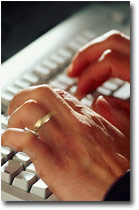Photo-lobbying - a New Way to Get Your Voice HeardText and photography copyright Niall Benvie. All rights reserved.
Return to Nature Photography 101 Index
Editor's note - While we avoid political discussions on NPN, we certainly encourage everyone to use their nature photography for a good cause - whatever that cause may be. Our sincere thanks to Niall for allowing us to reproduce this page on NPN. JE
 The long cherished belief amongst nature photographers that we can bring about positive environmental policy change merely by showing the public the beauty of nature is now largely discredited. The accelerating rate of biodiversity loss highlights our failure in the public arena and the need instead to target our efforts directly at the people in positions of power (pipop) - those responsible for formulating policy. New technology means that this is no longer the preserve of the professional lobbyist. Now, if you own a digital camera and have internet access, you can effectively lobby on behalf of the environmental issues that affect you in your neighbourhood.
The long cherished belief amongst nature photographers that we can bring about positive environmental policy change merely by showing the public the beauty of nature is now largely discredited. The accelerating rate of biodiversity loss highlights our failure in the public arena and the need instead to target our efforts directly at the people in positions of power (pipop) - those responsible for formulating policy. New technology means that this is no longer the preserve of the professional lobbyist. Now, if you own a digital camera and have internet access, you can effectively lobby on behalf of the environmental issues that affect you in your neighbourhood.
The concept of photo-lobbying is simple, its message delivered directly. Document those natural places and things in your area that enrich your life, that you would feel disappointed to see disappear - or whose destruction has angered you. We're not talking about wilderness here, just the ordinary places where most of us actually engage with nature on a daily basis. Then e-mail these images on a regular basis to your elected representatives - from parish councillor up to Senator or MEP. Once you've set up a mailing list it is easy and quick to repeat with fresh images. The message that accompanies the pictures is short and to the point:
- This matters to me,
- You are my elected representative,
- What are you going to do about it?
A visual statement is inherently more powerful - and quicker to prepare and assimilate - than a written one. Few of us actually bother to sit down and write protest letters - but many more of us enjoying taking a photograph. Central to the philosophy of photo-lobbying is the construction in the recipient's mind of the natural fabric of their constituency and what matters to a vocal, networked sector of their electorate. The photography need not necessarily be issues-led. Photo lobbyists are effectively advertising agents for nature in their area, with incessant repetition being the key to getting the message heard. Lazy (or overwhelmed) pipop can either delete or forward the e-mails to someone higher up the political food-chain to deal with. But the flow will keep coming. Indeed, sometimes politicians will find that they can advance their own prospects by championing a cause.
Photo-lobbying can work on a local level because residence lends authority and election obliges a response. No response, no vote.
Practicalities
Photo-lobbying is all about making elected representatives aware of what you value in your environment and calling them to account. But don't be a pain:

- Edit your pictures rigorously. Bad photos just give a bad impression.
- Keep the picture size fairly small (500 pixels along the long axis is adequate) and save the files as .JPG so that the final size is under 100 Kb. to speed up download times.
- Maintain an up-to-date list of democratic representatives whose e-mail addresses are in the public domain and send your images and comments to them using the Blind Carbon Copy (BCC) function of your e-mail programme.
- In your subject line, use something to suggest that your correspondence isn't spam. Try, "A message from one of your constituents"
- Don't attach any more than a couple of images per e-mail; this will speed up sending and download times. If you have you own website, post your pictures on it and send the link to the pictures instead; many people are justifiably wary of attachments.
- Get your facts right; identify species correctly and don't make statements that can't be verified. Be a credible witness for the wild.
- Working with like-minded people in your area for a co-ordinated effort is sensible but mail your pictures in an individual capacity; votes are held by individuals, not groups.
- Do not invoke the name of any organisation without its express permission.
- And remember, as in advertising, persistence and repetition are crucial.
NB-NPN 0018
Comments on NPN nature photography articles? Send them to the editor.
Niall Benvie, who runs Images from the Edge, is the UK’s most prolific writer on natural history photography, publishing almost 70 articles and a book (amounting to over 135,000 words) between 2000-2002 alone. But the scope of his writing extends much wider into issues of land management and the polarisation of nature and culture as well as travelogues and commentaries on subjects as diverse as species re-establishment programmes and eco-tourism.
Several thousand pictures from The Images from the Edge collection are accessible in its searchable online database.


| 


